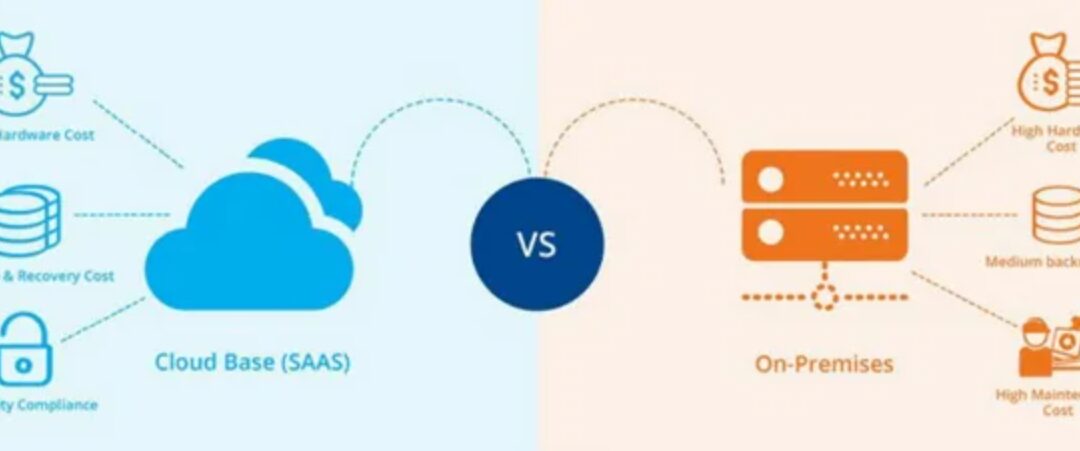

Many existing businesses wonder if switching from their on-site technical systems and move to the cloud is worthwhile.
Several younger businesses, on the other hand, wonder if they should spend their early resources in on-site systems.
There need to be conscious of the variations between on-site and cloud-based services technology to choose and which choice is right for your company.
Whenever you make a distinction between cloud and onsite, It’s important to think about the requirements of your organization if you do a cloud and on-site comparison.
Whatever choice you choose, there are tradeoffs, so you should be fully aware before you determine how many onsite or cloud services are included in your company.
There are many components that go into cloud systems and on-site systems.
You should concentrate on the differences between the two key elements of your solution to narrow it down: storage and software.
The way it stores data is one of the primary ways that the cloud interacts with your company.
Cloud storage uses remote servers operated by another organization, unlike an on-site server with storage.
Servers are the lifeblood of your enterprise, after all. They store your data, communicate with your staff, and allow you to connect with others around the world.
In the past, the only choices available were on-site servers.
For many businesses, cloud storage is a great choice, as it offers cost-saving advantages along with practical ones, such as daily data backups and the ability to scale easily.
For enterprise, cloud storage because it provides
1) Flexibility and Adapt to the budget:
To help enterprises keep their initial costs
down, on a month-by-month basis, companies frequently pay for cloud storage.
Most cloud-based storage companies will change their rates to suit
your budget, no matter whether you’re scaling up or scaling down.
In addition, cloud storage capabilities may be
updated, integrated or left out of plans altogether.
For businesses who expect change and don’t want to get stuck into
paying for services they don’t need, this sort of flexibility is fantastic.
2) Eliminate capital expenses:
Cloud storage is considered an operating
cost, while on-site storage is considered a capital expense.
On-site storage usually requires a substantial initial investment
to buy equipment and install it in the office.
There is no need for investment in capital
as cloud computing is taken care of externally.
Instead, businesses can pay a monthly subscription that is affordable
3) Reduce the non productive workload for IT employees:
When other organization handles your cloud storage, the IT workers will not
Be spending the time to install new software fixes or upgrades, freeing up their time for other more important task
4) Frequent data backups:
The cloud provides faster data backups than on-site backups.
Adapt to the needs of your business: Cloud-based storage is designed for scale.
To store more data, do you need a few extra terabytes of data?
Unlike a company’s own servers that need to add new hardware,
cloud-based servers can be easily extended to suit the company’s needs.
Why can’t cloud storage be the perfect option?
Although using the cloud for your computing needs has some advantages, it still comes with several disadvantages.
1) The Internet defines user experience:
A fast and secure internet service is a must-have when you use cloud storage.
If a lot of the workload would be hosted in the Cloud, a redundant Internet connection should also be considered.
It can be a boring process to open your files or download them if you have a sluggish link.
A poor internet connection will offer a terrible user interface
2) With little alert, costs will balloon:
If left unmanaged, the rapid scalability of cloud computing, though an asset mentioned above, can also be a costly deterrent.
Cloud platforms are models of consumption, meaning the greater the monthly cost, the more capacity your company needs.
To prevent the disappointment of an expensive invoice, businesses should devise strategy and procedure to reduce cost when operating on a cloud platform
Inside the Business, a single contact point should be identified, one who is key responsible for the Cloud relationship
3) Access is dependent on connection:
A drawback to relying on the internet to store your files is that your access to critical files can be absolutely wiped out by an internet interruption.
During a link outage, losing access to the data will disrupt your activities and make it difficult to be effective for employee.
While the internet’s stability has come a long way over the years, before they turn to cloud computing, enterprises must be secure in their link.
4) Litigation-search warrant:
If you deal with the cloud service provider, you entrust your data protection to another entity to handle and secure confidential data.
Whenever your business knowledge or data is trusted by an outside entity, you run the risk of unauthorized personnel accessing it.
If an investigation focuses on your company, law enforcement may use a search warrant without your authorization from your cloud provider to check for items that assist an investigation.
To complement the cloud storage program, businesses should have written instructions and appropriate usage policies.
To prevent this, you may want to inquire about the Cloud company’s protection policies and protocols and how the data is encrypted when it’s in transit and at rest
ADVANTAGES for IN-PREMISES STORAGE
In comparison to cloud storage, onsite storage depends on the company’s brick and mortar office system to handle the files.
You will own all the facilities and you will be liable for the maintenance of the lifecycle.
There are some pros and cons of on-site data storage systems.
While cloud storage has recently become all popular, some businesses also find that on-site systems are better tailored to their business needs.
For one, many appreciate the greater protection of their data offered by on-site solutions and storage.
For your business, on-site storage is a perfect choice because it can:
1) Operate without the internet:
One of the key benefits of on-site storage is that it does not enable users to access data through an internet connection.
Although most organizations rely on the internet to do business, there is still a concern that and make it difficult to access essential information.
Onsite servers would provide you with an internal network that, no matter the internet connection, is available at any time.
2) Lower monthly bandwidth costs:
You do not need to pay for such a high-speed link if your company doesn’t rely on the internet or cloud-based resources.
The need for a good link with fast transfer rates is much more minimized for those with on-site storage.
Based on your preferences, if you don’t have to use the cloud to download files, you do not have to opt for a more costly Internet service.
3) Provide enhanced security:
On-site storage is entirely restricted to those other than permitted
employees, unlike cloud storage, which is more vulnerable to third parties and prying eyes.
Onsite computers, since they do not store data electronically, are not open to anyone in the network
Onsite storage could be a preferable choice for organizations that manage confidential data, such as those in the finance sector.
4) Give power over cloud hardware:
Certain firms love providing dedicated servers to handle all their needs within their premises.
The organization will easily perform the updates itself, instead of trying to persuade
a cloud service company to update their storage plan or add additional functionality.
Potentially, being able to change the hardware of the server will provide more versatility and customization to smart enterprises for their storage needs.
Why storing on-premises may not be the best choice
There are some pitfalls that organizations should be mindful of, considering the many opportunities that come with on-site storage.
Storage on premises could not be the right solution for your company so it can
1) Need additional IT support:
You would still need to provide IT workers to administer and operate the servers if you believe you choose to use on-site storage.
This could mean that you have to recruit additional team members or devote more effort to running the servers for your existing employees.
As they will have expanded duties along with onsite servers, this added assistance can add to the expenses and decrease the productivity of your IT department.
2) Compliance with market compliance:
If the business works within a controlled industry such as Banking or HealthCare, the company would
be responsible for complying with the applicable legislation and you are the owner and operator of the servers and on-site storage.
Enforcement, if the infrastructure is shown to be out of compliance, will require the involvement of several workers, extra funds for external investigations and future fines.
3) Increase operating costs:
You will also need to pay to procure computers, software and licenses to update
or restore the device, along with the original capital investment needed to buy servers and other hardware.
A piece of hardware can always fail and must be replaced.
In addition, you may want to update your equipment, which is likely to be periodic (at least),
and will entail an investment of more money in order to get best from your server investment.
4) Require a larger capital investment:
You would have to spend a large amount of capital to buy the servers and other pieces of infrastructure when you first set up on-site storage to get it running.
This amount of capital spending can be a major drawback for businesses only starting to get off the ground.
In addition to buying the machinery, you would still need to pay time and cash to ensure that it is fully mounted.
5) Increase the chance of lack of data:
The foundation of the organization is data. For both your productivity and your
reputation, losing it may be debilitating.
An error in the system or a corrupted system kept for ransom will cause you to permanently lose your data by on-site storage.
Although the data would be backed up by a cloud-based device, on-site storage services have all
the data stored on an internal disk, ensuring that you assume a larger level of risk.
To prevent data failure, the best approach for on-site backups is to provide an off-site archive.
The principle of storage is to provide an offsite backup facility that replicates the data to another site or media to deter data loss.
6) Limit the capacity of your company to expand:
It is more difficult to scale up with the on-site servers when there is a demand for computing capacity space .
If you compare the on-premise and cloud storage choices, make sure to consider the pros and cons of each one.
When you choose your service provider, ask the necessary questions to ensure that you get the right choice for your company.


Recent Comments